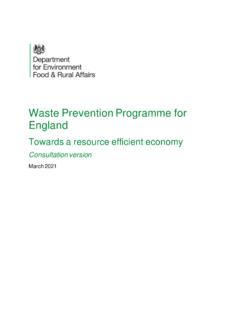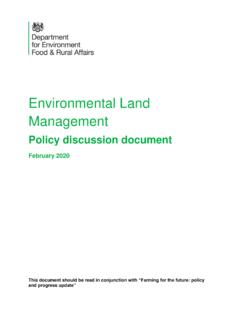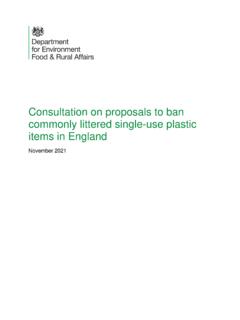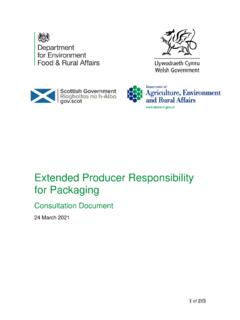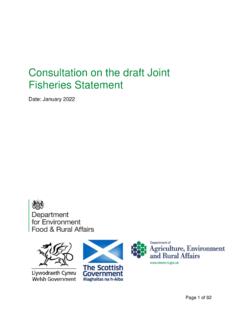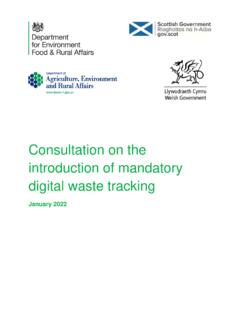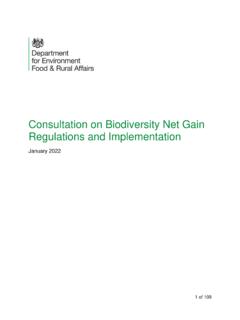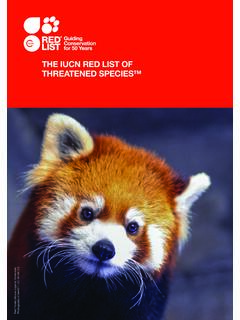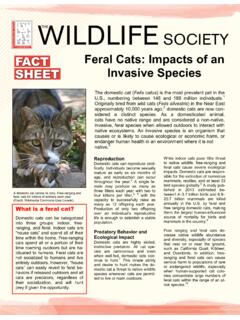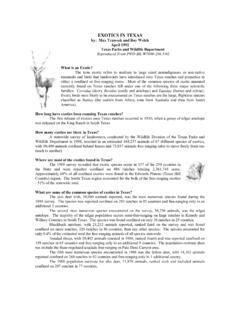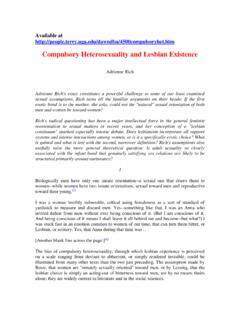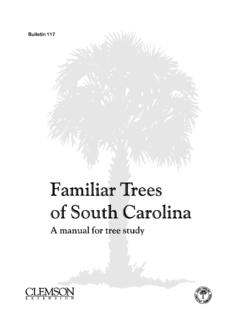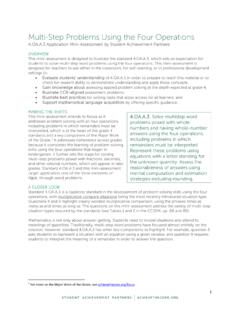Transcription of Nature recovery green paper: protected sites and species
1 Nature recovery green paper: protected sites and species March 2022. We are the Department for Environment, Food and Rural Affairs. We're responsible for improving and protecting the environment, growing the green economy, sustaining thriving rural communities and supporting our world-class food, farming and fishing industries. We work closely with our 33 agencies and arm's length bodies on our ambition to make our air purer, our water cleaner, our land greener and our food more sustainable. Our mission is to restore and enhance the environment for the next generation, and to leave the environment in a better state than we found it. Crown copyright 2022. This information is licensed under the Open Government Licence To view this licence, visit This publication is available at Any enquiries regarding this publication should be sent to us at 2 of 42.
2 Contents 1. Foreword ..4. 2. Introduction ..6. 3. Protecting wildlife sites on land and at sea ..8. A new consolidated Site management and protection promoting scientific 4. Delivering 30 by 30 ..21. What should count ..21. Delivering our commitments at sea ..24. 5. Protecting Consolidation and rationalisation ..26. Tiered approach to species protection ..27. 6. Delivering Nature recovery ..28. Delivering for Nature through public bodies ..28. Financing Nature recovery ..31. 7. Introductory questions ..33. Consultation questions ..34. 8. How to respond ..41. 9. Confidentiality and data protection ..41. 3 of 42. 1. Foreword The UK is sadly one of the most Nature depleted countries in the world. Over the last 50. years, much of the UK's wildlife- rich habitat has been lost or degraded, and many of our once common species are in long-term decline.
3 As I set out in my Delamere Forest speech, we are putting a renewed emphasis on Nature 's recovery . Following our departure from the EU, we are introducing a new framework of environmental targets under the Environment Act. The target to halt the decline in species abundance by 2030 will be our compass, which will deliver our commitment to leave the environment in a better state than we found it. The task before us is significant, and clearly the current approach is not delivering the pace of change we need to see. So, we want to grasp the opportunity to look afresh at how to best protect and restore Nature at home, and whether our existing regulatory, designation and delivery mechanisms will help us to deliver our species target and meet our commitments to protect 30% of land and sea by 2030. Our environmental regulatory landscape for protected sites and species has become too complex.
4 For example, the current landscape is a muddle of different types of site designations, grown up over decades, often seeking to achieve the same thing and quite often overlapping for largely technocratic reasons. Over 80% of our sites of Special Scientific Interest (SSSIs) by area are also designated as Special Areas of Conservation (SACs) and Special Protection Areas (SPAs). This SSSI. underpinning' has provided the key delivery and management functions for terrestrial SACs and SPAs. In some cases, SAC and SPA designations have focused on the existing SSSI resource, recognising that many SSSIs are also of international importance. In these cases, there has been little or no need to amend the existing site management despite this layering of additional designations. Similarly, in the marine environment there are domestic Marine Conservation Zones, SACs and SPAs.
5 The layering of these different processes and obligations distracts from our ability to focus resources strategically or holistically on actions on-site and pressures off site in a way that best delivers for Nature . Alongside this, very few members of the public are likely to know what these terms mean, or why these sites are worth protecting. This element is crucial to public engagement with and support for this work. We want to simplify and streamline environmental regulation, with a focus on delivering the legally binding targets now enshrined in the Environment Act. We've also seen the legislative system create pressure to designate some areas where other designation types, or other actions entirely, would have made more sense for the outcomes we're trying to achieve. 4 of 42. We'd like to move towards a system where scientific judgement has a greater role, rather than action being led solely by legal process.
6 We want regulators to be able to make expert judgements based on the best available science and evidence about what will improve the environment and support Nature 's recovery in local geographies. In this paper, we aim to consider what we are trying to achieve with different designations. Could we instead have a single type of designation on land with different tiers of protection which would bring more consistency to the legal requirements, while enabling a tailored approach to better drive the recovery of each site? We consider the same questions for our approach to species . This paper also explores how we can make space for Nature in new areas and better reflect our goal of not only halting the decline in Nature but restoring it. By simply letting go of the reins, we can give Nature the space to return in relatively short timeframes.
7 This will go hand in hand with our wider work with willing landowners through the financial incentives in the Landscape recovery and Local Nature recovery schemes. So, we also aim to explore additional approaches that recognise that even if an area might not have any obvious so-called legally defined special features' today, it can still be identified and protected in ways that allow Nature to reclaim it. We've seen significant improvements in on farm biodiversity in areas like Hope Farm through better joined up environmental and agricultural thinking. Hope Farm is an example of how an integrated approach to farming and land management can benefit Nature whilst producing food. We will make it easier for more farmers to work like this through our Environmental Land Management schemes. We need to encourage more of these initiatives to enable Nature 's recovery .
8 We want to achieve greater balance, with environmental considerations underpinning conversations about all kinds of sites . Finally, we have an opportunity to look at how those tools we have available to us to protect and restore Nature are used and by who. Much like Nature regulation, the Defra Arms' Length Body (ALB) landscape has grown up over time and has elements of overlap. We would like to see more flexibility and accountability given to those delivering our policy on the ground, so they are able to be more joined up and respond to the specific circumstances of particular sites and areas. We want to explore an approach to decision making that enshrines democratic accountability more consistently whilst protecting regulatory independence where appropriate. We want to make sure that our ALBs are equipped to enable Nature 's recovery .
9 I recognise that there are things with our current system that are working, so we need to tread with care. But this is a critical opportunity to think through a coherent, modern approach to protected sites and species . The ultimate goal of this work is to better enable Nature 's recovery . 5 of 42. As we continue our work to build back better and level up our country, the health of our environment and access to it has never been more crucial. This paper sets out our proposals to get us on track to 2030 and beyond. Rt Hon George Eustice MP, Secretary of State for Environment, Food and Rural Affairs 2. Introduction Following our departure from the EU, the UK Government has set out a new framework of environmental targets under the Environment Act 2021 (the Environment Act). This includes an ambitious target on species abundance, with the objective to halt the decline in Nature by 2030.
10 Further targets will shortly be set relating to matters such as water quality, species extinction and habitats. The UK Government has also committed to protect 30 per cent of our land and sea by 2030 ( 30 by 30'), and to reach net zero emissions by 2050. Nature will play a crucial role in delivering our climate targets, particularly as a carbon sink, and in improving our climate resilience. Two further Acts of Parliament passed by this Government create the powers to help deliver these ambitions. The Fisheries Act 2020 created a new system of sustainability objectives and the powers to manage our marine resources. The Agriculture Act 2020. creates the powers needed to change the way we support farmers and enhance the farmed landscape. The Sustainable Farming Incentive will incentivise interventions that promote soil health and biodiversity, sensitive hedgerow management and Integrated Pest Management.
